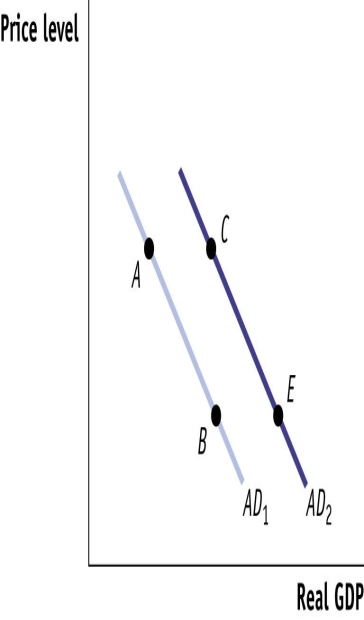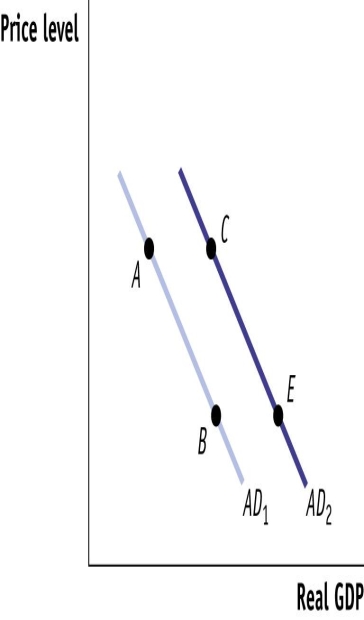A) Fiscal policy works to shift aggregate supply to potential GDP.
B) Monetary policy works to shift aggregate supply to potential GDP.
C) As prices begin to adjust, businesses adjust production and the economy recovers to potential GDP.
D) The level of production in the economy reduces until a certain fixed level.
Correct Answer

verified
Correct Answer
verified
Multiple Choice
An increase in Social Security benefits will likely ____ consumption and shift the aggregate demand curve to the ____.
A) increase; right
B) increase; right.
C) increase; left
D) increase; left.
E) not change; left
F) not change; left.
G) decrease; left
H) decrease; left.
Correct Answer

verified
Correct Answer
verified
Multiple Choice
Why is the very short-run aggregate supply curve horizontal?
A) Businesses have not adjusted their prices yet after an economic shock.
B) This is the price ceiling for the economy.
C) Production has returned to potential GDP levels.
D) This is the price level consistent with the Federal Reserve's inflation target.
Correct Answer

verified
Correct Answer
verified
Essay
How do the multiplier and crowding out affect AD?
Correct Answer

verified
Correct Answer
verified
Multiple Choice
A fall in prices causes:
A) a leftward shift of the aggregate demand curve
B) a rightward shift of the aggregate supply curve.
C) a rightward shift of the aggregate demand curve.
D) movement along a curve, not a shift in a curve.
Correct Answer

verified
Correct Answer
verified
Multiple Choice
Given your knowledge of how aggregate supply changes from the very short run to the long run, what is the IMMEDIATE impact of a decrease in aggregate demand?
A) All prices adjust, and the economy returns to long-run potential.
B) There is a slow fall in prices as the short-run aggregate supply begins to have a positive slope, and the initial decline in output will moderate.
C) There is a sharp fall in prices as business hurriedly lower prices to try to boost sales.
D) There is a recession as output falls sharply, and prices will not have had time to adjust.
Correct Answer

verified
Correct Answer
verified
Essay
How do changes in each of these variables affect aggregate supply? (i) The Brazilian economy experiences a decline in productivity. (ii) An agricultural-based economy faces high costs for imported farm machinery and equipment. (iii) The Organization of the Petroleum Exporting Countries (OPEC) increases production of oil and thus lowers oil prices.
Correct Answer

verified
Correct Answer
verified
Multiple Choice
(Figure: Shift of the Aggregate Demand Curve) Use Figure: Shift of the Aggregate Demand Curve. A movement from point C on AD2 to point A on AD1 may result from:

A) an increase in investment spending following optimistic GDP forecasts
B) an increase in investment spending following optimistic GDP forecasts.
C) a decrease in investment spending following pessimistic GDP forecasts
D) a decrease in investment spending following pessimistic GDP forecasts.
E) a decrease in taxes paid by businesses
F) a decrease in taxes paid by businesses.
G) lower interest rates.
H) lower interest rates
Correct Answer

verified
Correct Answer
verified
Multiple Choice
Ceteris paribus, an increase in imports leads to a:
A) movement up and to the left along the same aggregate demand curve.
B) movement down and to the right along the same aggregate demand curve.
C) right shift of the aggregate demand curve.
D) left shift of the aggregate demand curve.
Correct Answer

verified
Correct Answer
verified
Multiple Choice
Suppose that the Kenyan government engages in expansionary fiscal policy. Ceteris paribus, which of the graphs shows the correct effect in the AD-AS framework?
A) ![]()
B) ![]()
C) ![]()
D) ![]()
Correct Answer

verified
Correct Answer
verified
Multiple Choice
When inflation falls below its target rate, the Federal Reserve will:
A) increase taxes.
B) place a ceiling on interest rates.
C) raise interest rates.
D) lower interest rates.
Correct Answer

verified
Correct Answer
verified
Multiple Choice
When prices fall in Germany, what is the effect on consumption and aggregate expenditure in Germany?
A) Real interest rates rise, and this decreases consumption and aggregate expenditures.
B) The real value of wealth decreases, leading to a decrease in consumption and a decrease in aggregate expenditure.
C) The real value of wealth increases, leading to an increase in consumption and an increase in aggregate expenditure.
D) The real value of debt increases, and this increases consumption and aggregate expenditure.
Correct Answer

verified
Correct Answer
verified
Multiple Choice
In the AD-AS framework, price and quantity are represented by _____, respectively.
A) the GDP deflator and the real GDP
B) the real GDP and the real interest rate
C) nominal interest rates and the real GDP
D) the real interest rate and consumption
Correct Answer

verified
Correct Answer
verified
Multiple Choice
Expansionary monetary policy _____ consumption, investment, and net exports; _____ aggregate expenditures; and _____ aggregate demand.
A) increases; boosts; raises
B) decreases; boosts; raises
C) increases; lowers; lowers
D) decreases; lowers; lowers
Correct Answer

verified
Correct Answer
verified
Multiple Choice
The short-run aggregate supply curve is:
A) downward sloping.
B) downward sloping
C) upward sloping.
D) upward sloping
E) horizontal at the natural rate of unemployment
F) horizontal at the natural rate of unemployment.
G) vertical at potential output
H) vertical at potential output.
Correct Answer

verified
Correct Answer
verified
Short Answer
When the government raises government spending by $50 million, what is the final effect on GDP if the multiplier is 2.5?
Correct Answer

verified
Correct Answer
verified
Multiple Choice
The U.S. dollar appreciates. Ceteris paribus, which of the graphs shows the correct effect on aggregate supply?

A) Figure A
B) Figure B
C) Figure C
D) Figure D
Correct Answer

verified
Correct Answer
verified
Multiple Choice
A 25% tariff on steel imports is implemented. Ceteris paribus, which of the graphs shows the correct effect on the AD-AS framework for the importing country?
A) ![]()
B) ![]()
C) ![]()
D) ![]()
Correct Answer

verified
Correct Answer
verified
Multiple Choice
(Figure: Shift of the Aggregate Demand Curve) Use Figure: Shift of the Aggregate Demand Curve. A movement from AD1 to AD2 may result from:

A) an increase in government spending
B) an increase in government spending.
C) a decrease in government spending
D) a decrease in government spending.
E) an increase in personal income taxes.
F) an increase in personal income taxes
G) a decrease in consumer wealt
H) a decrease in consumer wealt.
Correct Answer

verified
Correct Answer
verified
Multiple Choice
Ceteris paribus, an increase in exports leads to a:
A) right shift of the aggregate demand curve.
B) left shift of the aggregate demand curve.
C) movement up and to the left along the same aggregate demand curve.
D) movement down and to the right along the same aggregate demand curve.
Correct Answer

verified
Correct Answer
verified
Showing 41 - 60 of 169
Related Exams